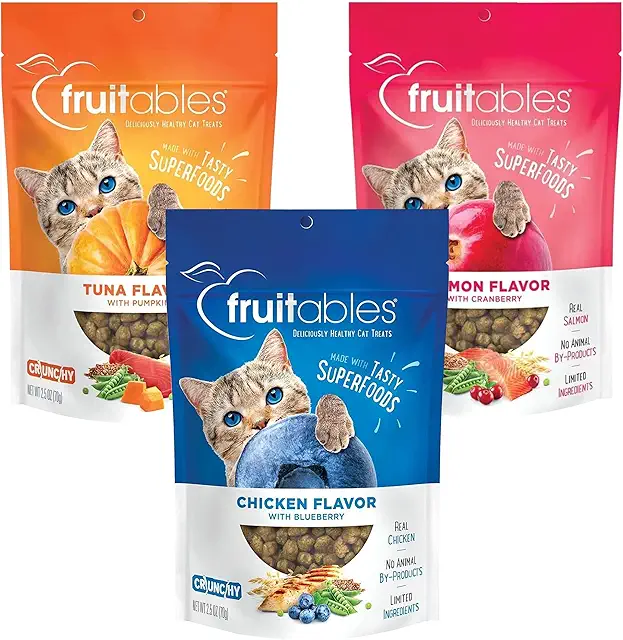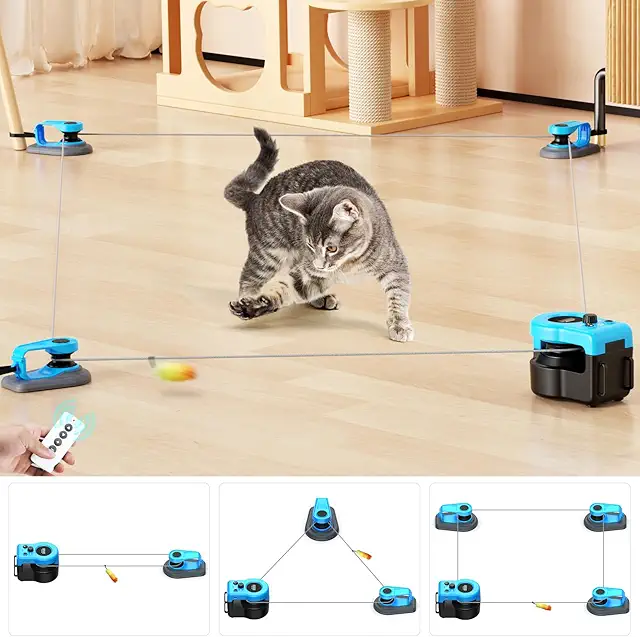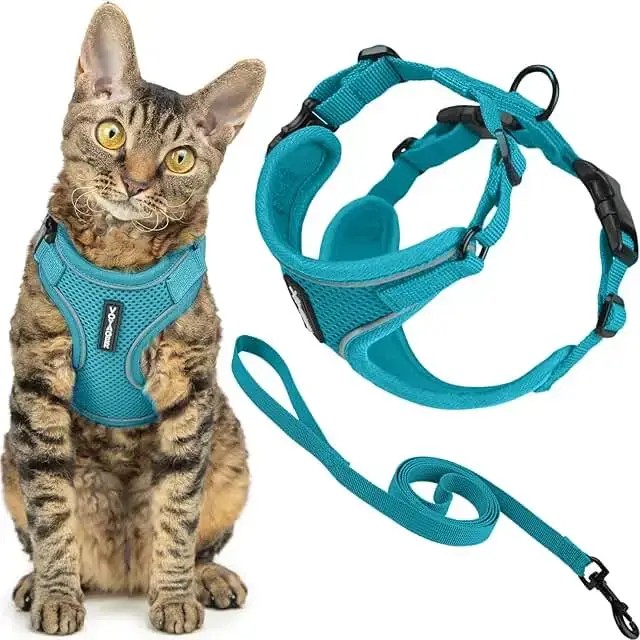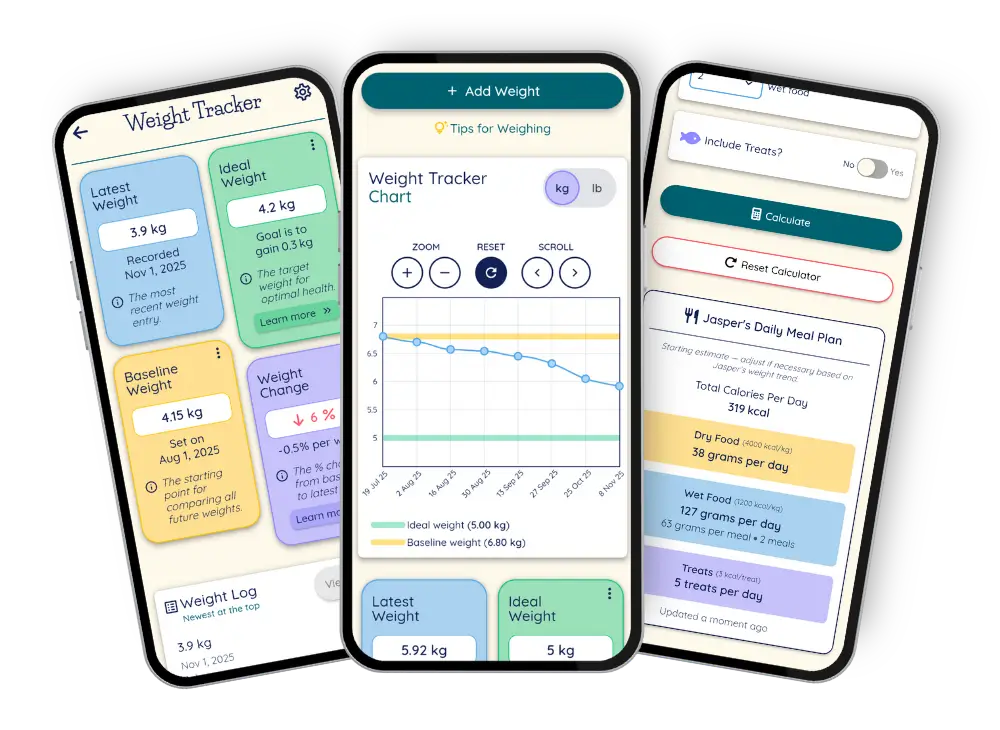Why Is My Cat Fat? 14 Reasons Cats Become Overweight
Updated

Introduction
Obesity in cats is the most commonly diagnosed nutritional disorder, and the number of overweight and obese cats has risen over the years. The latest figures suggest an estimated 60% of cats in the USA (Pet Obesity Prevention), 53% of cats in the UK (PDSA), and 32% of cats in Australia (Australian Veterinary Practitioner) are overweight or obese.
As a veterinarian, it's not uncommon for owners to ask me, "Why is my cat so fat?" and "Why is my cat gaining weight?"
Simply put, a cat becomes overweight when they take in too much energy (calories in food) and don't expend enough energy (exercise). Over time the excess energy is stored as fat. However, this explanation oversimplifies the issue and overlooks the intricate and multifactorial reasons behind feline obesity. Therefore, I have compiled 14 underlying causes that can contribute to weight gain in cats.
1. Cats Not Working for Food
Wild cats typically eat 7-20 small meals throughout the day, such as birds, reptiles, and rodents. They expend energy hunting each meal, and only some of these hunts will be successful. Providing domestic cats with all their food in a bowl reduces their activity levels, they burn fewer calories and are prone to becoming overweight.

To encourage cats to work for their food, it's recommended to use puzzle feeders, which provide mental and physical stimulation, slow down their eating, and help prevent boredom.
Recommended Puzzle Feeders
| Product | Product | Features | Price |
|---|---|---|---|
 | Trixie Activity Fun Board |
| View on Amazon |
 | PetSafe SlimCat |
| View on Amazon |
 | Indoor Hunting Cat Feeder |
| View on Amazon |
 | Lickimat Slow Feeder |
| View on Amazon |
 | Snuffle |
| View on Amazon |
2. Cat Feeding Behaviour
Feeding all cats the same way without considering their individual feeding habits can lead to problems.
Some cats will regulate their food intake and maintain their ideal weight. Often these cats are grazers who eat little and often throughout the day. Cats that are grazers may have free access to food but be better at limiting the amount they consume.
Other cats are more food motivated and tend to overeat. Often they are bingers, quickly eating all the food in the bowl and then begging for more throughout the day. Cats that are bingers may be more prone to weight gain if food is provided ad-lib (available all the time). It's a false belief all cats naturally regulate their food intake and only eat as much as they need.
3. Showing Our Love With Food
We love our cats and love seeing them enjoy treats and titbits. However, too many extra foods can quickly lead to weight gain, especially if these calories are not accounted for as part of their daily allowance. When feeding cats treats, they should get less of the main diet, and treats should not comprise more than 10% of the daily calorie intake. Find out how many treats you can give your cat a day with our Cat Treat Calculator.

Some owners also feel their cats would be miserable if they had to eat less food or give up treats. However, instead of offering more food or treats, we can find other ways to bring joy to their life, such as cuddling, grooming, enrichment, and playing. However, it's certainly unlikely we are going to give up treats completely, therefore, consider low-calorie treats, or even vegetables, such as carrots and courgettes.
Recommended Low-Calorie Treats
| Product | Empty | Features | Price |
|---|---|---|---|
 | Hills | Hill's Metabolic Crunchy Cat Treats
| View on Amazon |
 | Greenies | Greenies Tempting Dental Treats
| View on Amazon |
 | Fruitables Cat Treats |
| View on Amazon |
 | DentaLife | Purina DentaLife Dental Treats
| View on Amazon |
4. Unwitting Sources of Calories
Cats can obtain calories from sources we may not have even considered. For example, secretly consuming food left out on the kitchen work surface. Fish oil is wonderful for their coat and joints, but it contains calories that need to be considered. Cat milk given once a day may help improve their hydration but can be quite fattening. Dental treats may help keep their teeth healthy, but the extra calories are often overlooked.
Giving medications in food can add a surprising amount of calories. For example, a small 15g piece of cheese is equivalent to the average human adult eating two cheeseburgers!
Outdoor cats may have additional opportunities to source extra food, such as unsecured trash, stealing from the cat next door, or the neighbors could even be putting food out for them. It's also easy to accidentally feed your cat twice if different family members don't realize they've already been fed that morning or evening.
- High-quality and durable tag
- An excellent solution for cats that go outdoors and are being fed additional food by others
- Unique personalization of the tag included
5. Lack of Portion Control
Providing more food than the package feeding guidelines recommend or not weighing out food and guessing how much to give your cat can easily lead to weight gain. Using a measuring cup may also result in weight gain as they are imprecise, and a study found owners might accidentally overfeed up to 80% extra food.Also, a standard cup should be 250 ml/8 oz, but some people may not realize the 'cup' or scoop they use is larger.

The best way to measure food for precise portion control is with accurate digital scales, such as the affordable and reliable Amazon Basics Kitchen Digital Scales.
Amazon Basics Digital Kitchen Scale
- Affordable and reliable digital food scales
- Essential for accurately weighing your cat's food to prevent excessive weight gain
6. Not Adjusting Your Cat's Food Intake
Although feeding guidelines on food packages are based on scientific equations, it must be remembered these are only guidelines and should be used as a starting point. The amount of food cats require will vary due to individual differences in metabolism and activity levels, and may need to be adjusted based on monthly weight checks. Some outdoor cats may also be less active in the winter and more active in the summer, so the amount of food provided needs to be adjusted accordingly.

7. Free Access to Food
Limitless access (ad-lib feeding) to highly palatable food will soon lead to weight gain in a food-motivated kitty.

8. An Indoor Lifestyle
Not all house cats will gain weight if provided with enrichment, exercise, and portion control. However, being indoor-only is certainly a risk factor for gaining excess weight if they have reduced activity levels.
To encourage your cat to exercise, we recommend creating a fun indoor play area for exploring, running, and climbing, using large cat trees, multi-leveled cat shelves, tunnels, and exercise wheels, as well as having a collection of interactive cat toys. Some cats may also enjoy walking outdoors on a leash and harness. Clicker training can also be a great way to provide mental and physical stimulation.
Exercise for Indoor Cats
| Product | Empty | Features | Price |
|---|---|---|---|
 | 1 | A high-quality and irresistible toy that encourages hunting behavior when swished along the floor and through the air. | View on Amazon |
 | 2 | An exciting feather toy that zooms around a rope track. Adjust the speed, direction, and path to keep it entertaining. | View on Amazon |
 | 3 | Cat School Clicker Training Kit Provide mental and physical stimulation as you teach your cat to fist bump, jump, and weave through your legs! It's a fun and bonding experience. | View on Amazon |
 | 4 | This comfortable and fully adjustable harness is perfect for starting indoors and gradually progressing to the garden, park, and even hikes! | View on Amazon |
 | 5 | Made from high-quality lightweight laminate birch that allows cats to gain momentum easily, and a moving luminous fish that grabs their attention. | View on Amazon |
 | 6 | A tall, sturdy, high-quality, affordable, and easy-to-assemble cat tree that's great for climbing and playing. | View on Amazon |
 | 7 | CatastrophiCreations Furniture Beautifully crafted multi-leveled wall-mounted shelves that are easy to install and an excellent way to encourage activity and exercise. | View on Amazon |
 | 8 | A multi-branching tunnel made from durable fabric that cats love for exploring, playing, and chasing. Hide kibble and play with toys in and around the tunnels to encourage activity. | View on Amazon |
9. Neutering
Once spayed/neutered (fixed), cats are prone to weight gain due to several factors, such as a reduced metabolic rate, an increased desire to eat, and reduced activity levels. A 10-30% reduction in daily caloric intake is often required to avoid weight gain. By carefully monitoring your cat's weight, adjustments in the amount of food provided can be made if necessary.
There are diets formulated specifically to help maintain a healthy weight after neutering, such as Royal Canin Appetite Control Spayed/Neutered for adult cats and Royal Canin Spayed/Neutered Kitten for cats less than 12 months of age that still require nutrition to support growth.
Diets Formulated for Spayed/Neutered Cats
| Product | Empty | Features | Price |
|---|---|---|---|
 | Royal Canin Appetite Control |
| View on Amazon |
 | Royal Canin Spayed/Neutered Kitten | Royal Canin Spayed/Neutered Kitten
| View on Amazon |
10. Multi-Pet Households
In a home with more than one cat, it can be challenging to ensure each cat only eats their allocated portion of food. One cat may eat more than their share or steal from the others.
Sometimes a cat will feel they are in competition with the others in the household, so they will eat as much as possible to keep the food from the others. By distributing food bowls throughout the home and reducing competition, they may start to eat a more normal quantity.

Microchip-activated pet bowls, such as the SureFeed Microchip Pet Feeder, provide an excellent solution for multi-cat households as they have a lid that only opens for the cat whose microchip is registered with the bowl.
- Only allows the cat whose microchip has been registered to eat from the bowl
- The RFID collar tag can also be used instead of a microchip
- Perfect for multicat households
- Prevents food stealing
- Helpful if cats are on different diets
11. Dry vs. Wet Cat Food
Dry cat food has been associated with weight gain, but this is likely because it's commonly fed ad-lib (free access), which can lead to weight gain in some cats. Dry food is also higher in calories compared to the same volume of canned food because dry food is about 10% water, whereas canned food is 75-85% water, which means the calories in canned food are diluted down. If given the same amount of calories, whether dry or wet, there may be no difference in the potential to gain weight.

12. Medications
Certain medications such as steroids, amitriptyline, and cyproheptadine can increase a cat's appetite and contribute to weight gain. Therefore, a cat receiving such medications long-term needs to have their food portions controlled and weight carefully monitored.

13. Genetics
A mutation of the canine pro-opiomelanocortin (POMC) gene has been found in some Labrador Retrievers and Flat-coated Retrievers, which is associated with increased body fat and food motivation. However, no gene has currently been identified as a risk factor for obesity in cats.
14. Medical Conditions
Medical causes of obesity are extremely rare in cats. Acquired hypothyroidism (low thyroid levels) may cause weight gain but is very rare in cats. Cushing's disease (overproduction of cortisol) can cause a potbellied appearance but is not commonly seen in cats and is usually associated with other signs, such as hair loss and increased thirst and urination. Acromegaly (overproduction of growth hormone) can be seen in cats and may cause weight gain, but typically the increase in weight is due to high levels of growth hormone causing enlarged bones and organs, rather than excessive fat.
FAQ: Overweight Cat Health
How Can I Tell if My Cat Is Overweight?
To determine if a cat is overweight and how severely overweight they are, they need to be assigned a body condition score, which involves a visual and hands-on assessment. A cat is then given a score, with 5/9 being an ideal weight, 6/9 and 7/9 being overweight, and 8/9 and 9/9 being obese. Check out How to Body Condition Score Your Cat for a step-by-step guide to learning the technique.

What Health Risks Are Associated With Obese Cats?
Obese cats are at an increased risk of diabetes, arthritis, and numerous other health problems. Not only is preventing obesity important for your cat's quality and length of life, but many overweight cat health problems are expensive to treat and manage. To find out more, read 12 Health Risks Associated With Feline Obesity.

How Can I Help My Fat Cat Lose Weight?
If your cat is overweight, read the highly effective Fat Cat Weight Loss Diet Plan to help improve their quality of life and reduce obese cat health risks. It consists of 5 essential steps to help your cat lose weight, inspirational before and after weight loss pictures of cats, a calculator for daily treat allowance, a trouble-shooting guide (because diets can be challenging), and tips to keep your cat slim after successful weight loss.

Should I Take My Fat Cat to the Vet for Weight Loss?
If your cat is overweight, it is recommended to take them to a cat-friendly practice passionate about providing care for overweight cats and helping with their weight loss journeys.
Not only is it important to have the support of a veterinarian and veterinary nurse, with regular follow-ups to help maintain commitment and motivation, but usually, a prescription diet is required for safe and effective weight loss. Simply cutting back on their regular food will reduce the calories but can result in unbalanced nutrition. Therefore, prescription diets are calorie-dilute and nutrients dense to promote weight loss while preventing nutritional deficiencies. In addition, they contain adequate fiber to help your cat feel full, adequate protein to prevent muscle loss, and healthy ingredients that help support your cat's metabolism.
Veterinary Prescription Weight Loss Diets
| Product | Empty | Features | Price |
|---|---|---|---|
 | Royal Canin Satiety |
| Royal Canin |
 | Hill's Prescription Diet r/d Weight Reduction |
| View on Amazon |
 | Hill's Prescription Metabolic |
| View on Amazon |
 | Purina |
| View on Amazon |
How Can I Prevent Obesity in My New Kitten?
Like all diseases, prevention is better than cure. By carefully monitoring your cat's body weight, feeding them appropriate nutrition, measuring out their portion of food for the day, limiting treats, preventing food stealing in multi-cat households, and thinking of creative ways to encourage exercise and make them work for their food, we can avoid excessive weight gain. For tips on how to prevent obesity, read 10 Healthy Ways to Keep Your Cat Slim.






















